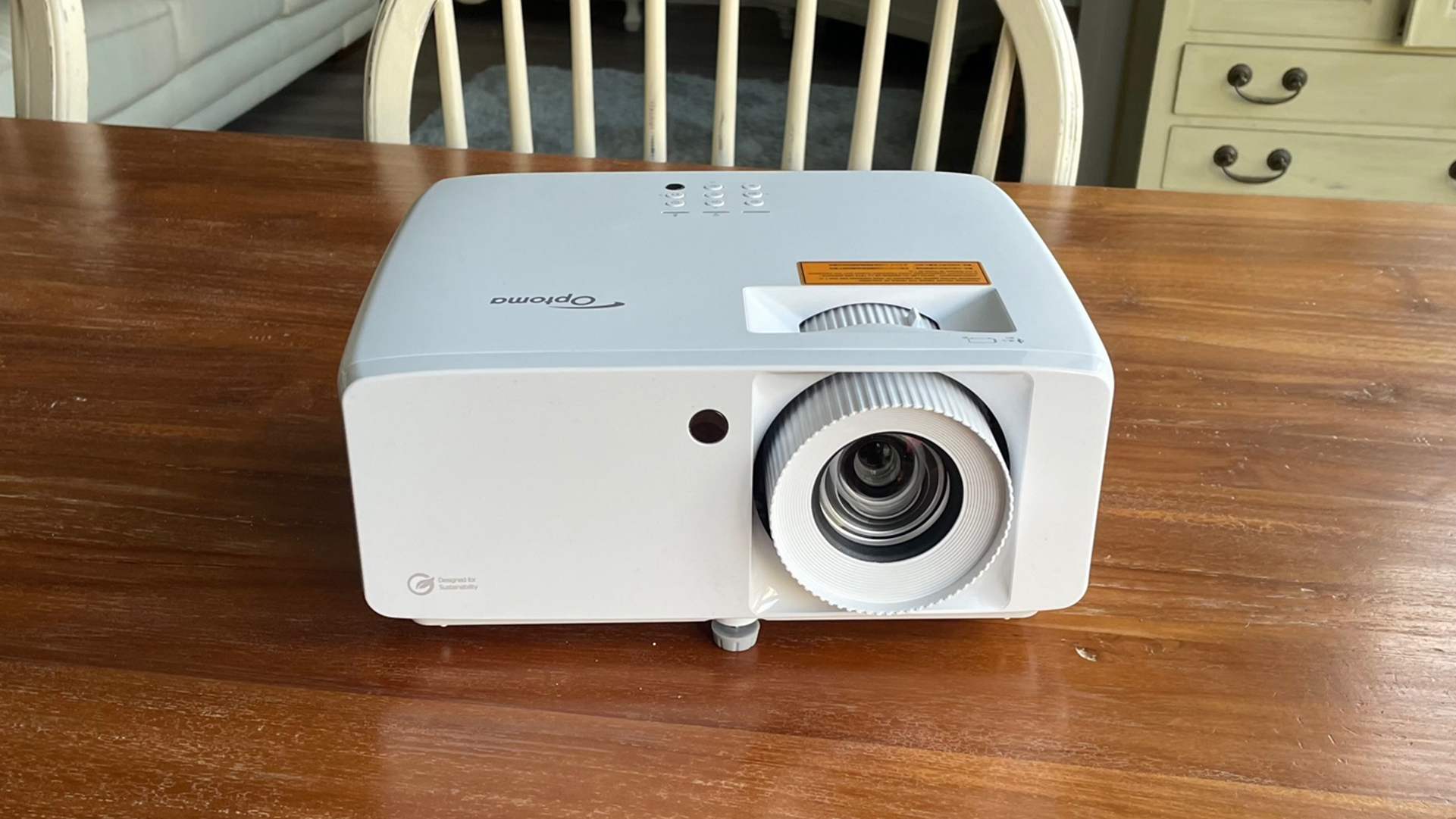What Hi-Fi? Verdict
At heart, the eco-friendly UHZ66 is a good projector, but its pursuit of HDR glory has blown it off course
Pros
- +
Bright enough to combat ambient light
- +
Unusually compact and portable design
- +
Sharp, detailed picture
Cons
- -
Washed-out colours and dark scenes
- -
Feels a touch expensive
- -
Very lightweight sound
Why you can trust What Hi-Fi?
While we’ve seen the projector world take a few small eco-friendly steps in recent years, no single projector model we know of has ticked as many green boxes as Optoma’s UHZ66. From its easy-to-ship petite size and extensively recycled build materials through to its ultra-long-life laser lighting and mercury-free design, it seems as keen to save the planet as it is to give you king-sized gaming and movie images.
Worthy though all this ecological concern might be, though, for most if not all of our readers, spending £1799 / $2299 on a home entertainment product needs to also provide them with some serious performance chops.
Price
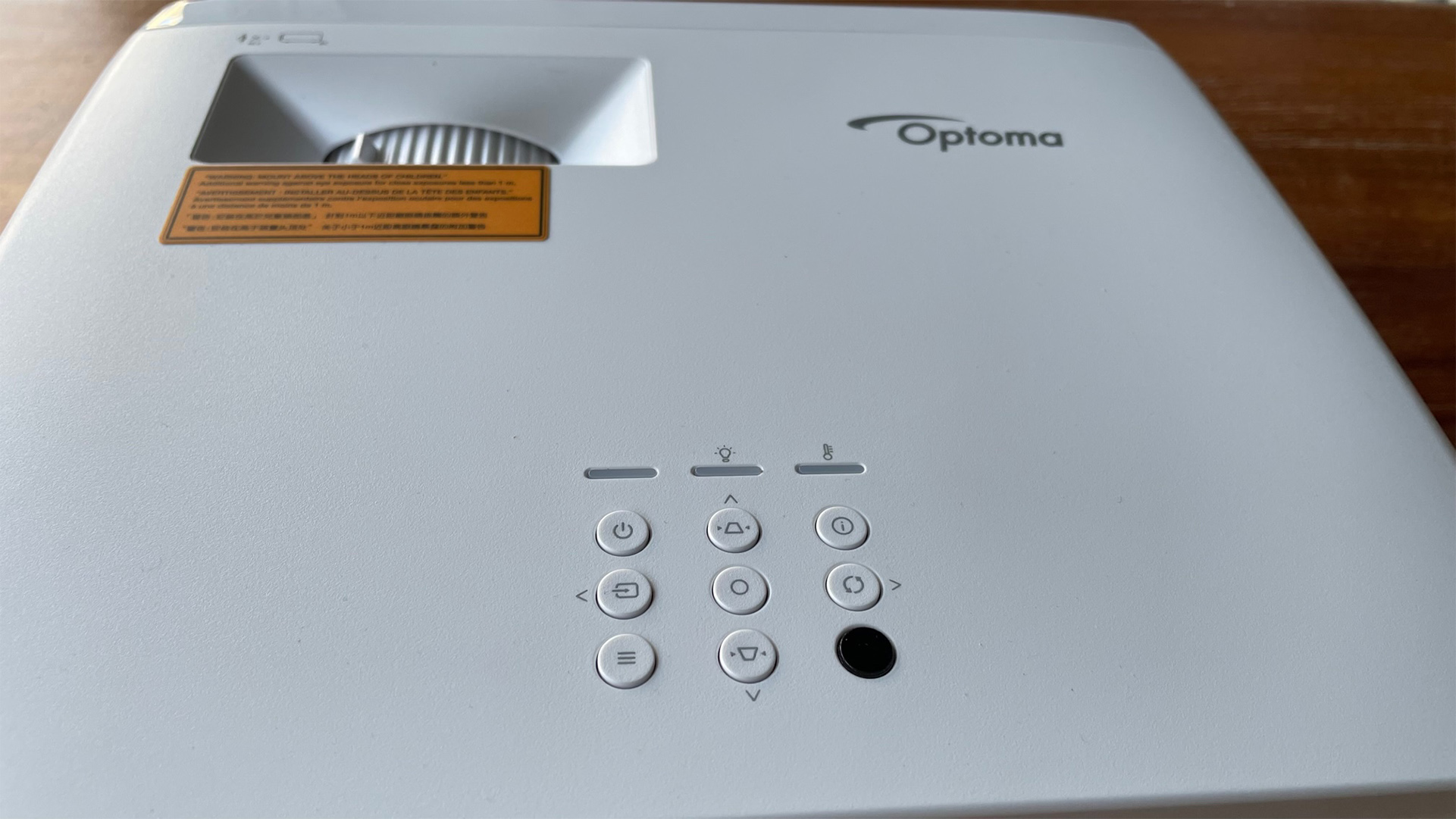
While there are plenty of lamp-based projectors out there that cost much less than the Optoma UHZ66’s £1799 / $2299 asking price, it’s actually pretty reasonably priced by the standards both of other 4K-capable laser projector models and those that use eco-friendly LED light systems.
Optoma rates its new projector’s lasers as good for up to 30,000 hours of life, too, meaning you won’t have to keep replacing bulbs at potentially hundreds of pounds a pop every 2000-5000 hours.
That said, the UHZ66’s price could still end up feeling a little steep if it isn’t associated with a compelling performance, so let’s hope Optoma hasn’t forgotten about that in its drive to go green.
Build & design
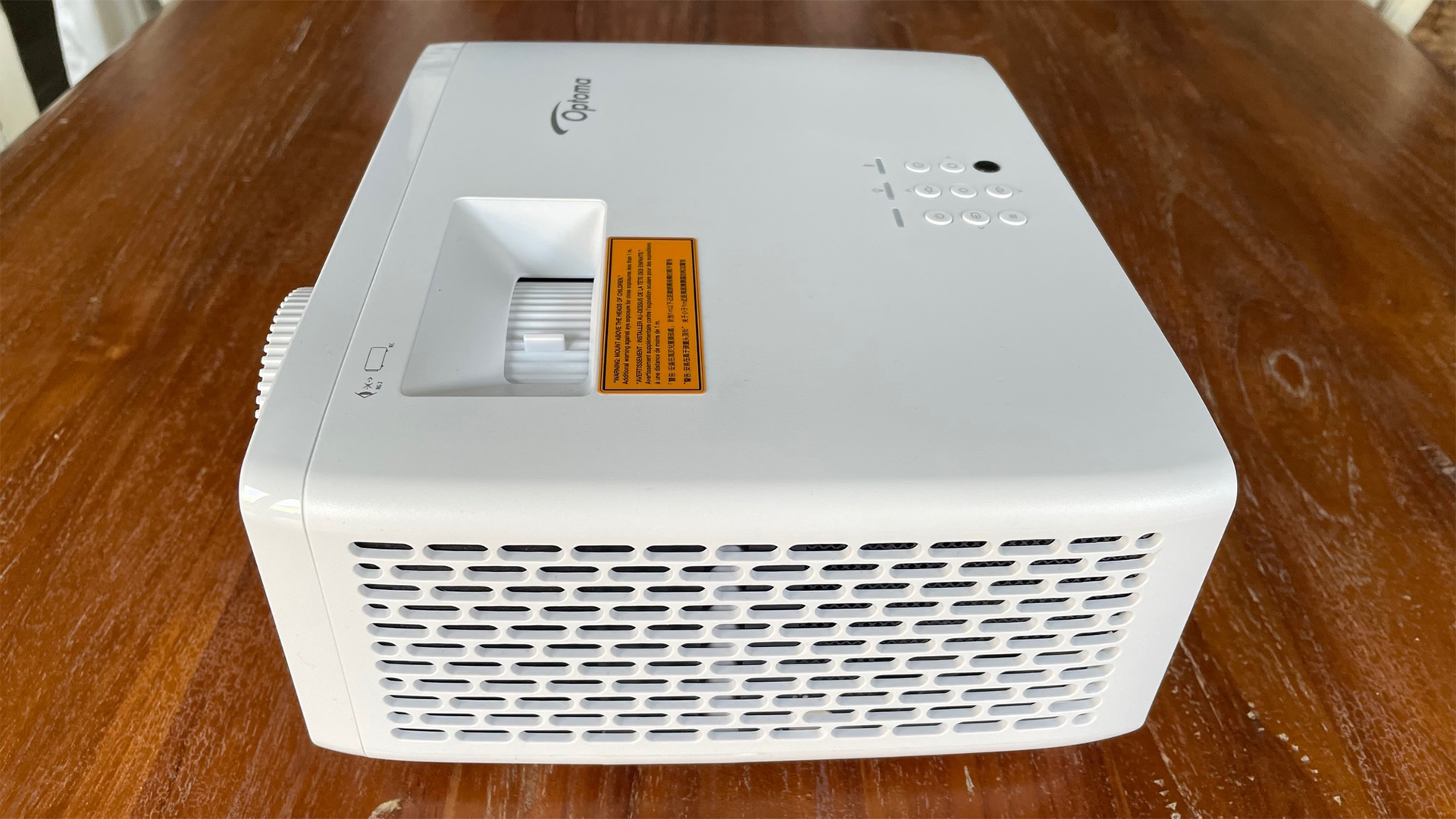
There’s more to say here than usual thanks to the UHZ66’s green credentials. So, according to Optoma, 50 per cent of the UHZ66’s chassis is made from consumer-recycled (PCR) materials; 97 per cent of the packaging the projector ships in is recycled; and the projector’s chassis is a remarkable 34 per cent smaller than that of its predecessor, leading to improved shipping efficiencies.
Optoma states, too, that the UHZ66 is completely mercury-free, and that its laser lighting system uses 45 per cent less power than regular lamp projectors.
The UHZ66 really is a very petite projector for a model that claims to be capable of delivering a pretty extreme amount of brightness and is apparently designed for both gaming and home cinema purposes. As well as meaning it takes up less of your precious coffee table space, its smallness makes it more portable than most home entertainment projectors if you’re looking for a model to move between rooms or homes.
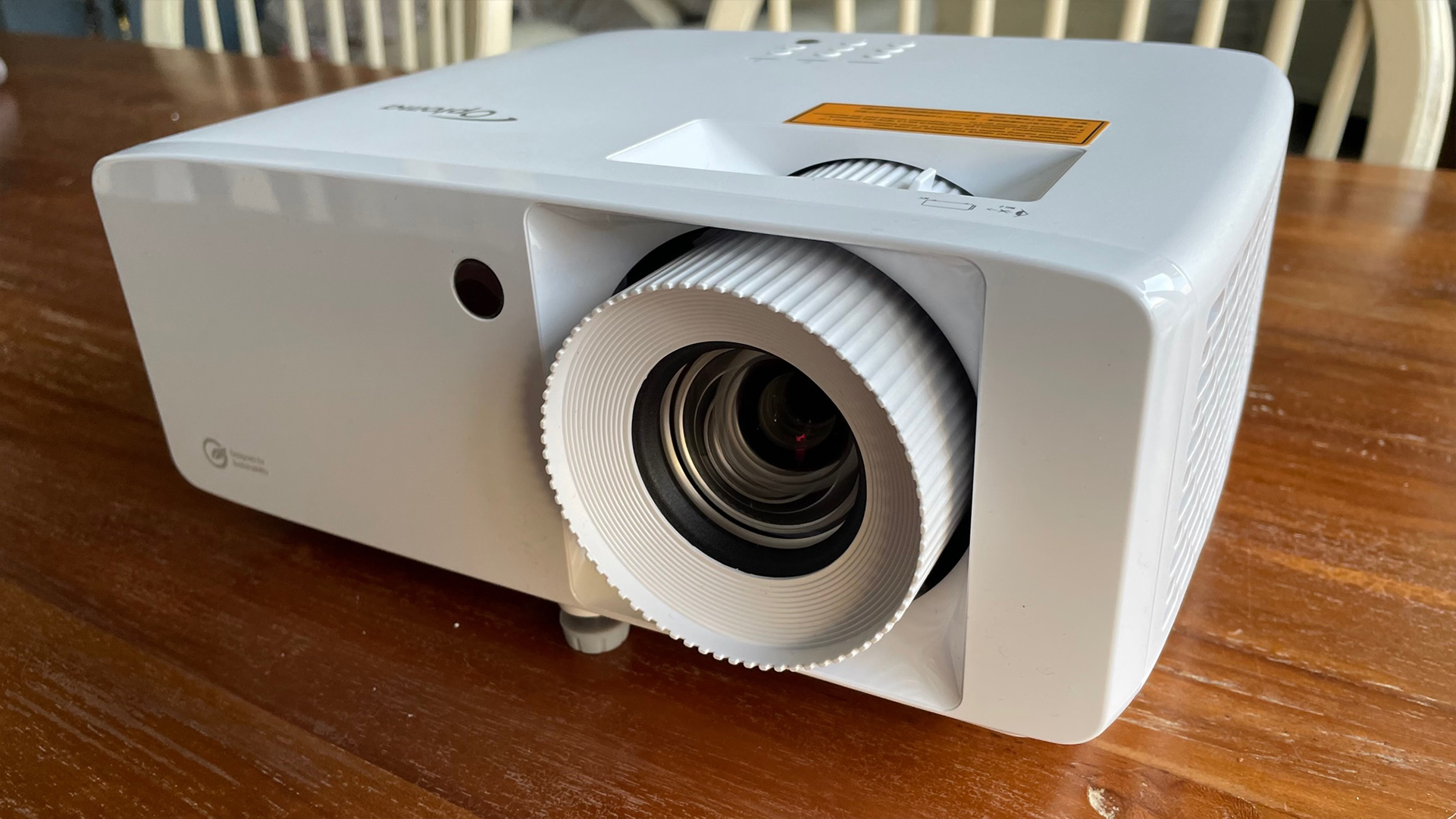
Projector type Laser Phosphor
Screen size Up to 303in (claimed)
Native resolution 3840x2160 (via DLP XPR pixel shifting)
Processing Dynamic Black auto contrast adjustment
Input lag with 60Hz in fast response mode 33.5ms
HDR support HDR10, HLG
Dimensions 15 x 60 x 35cm
The UHZ66 is crisply dressed in a sharp white finish, with extra style points earned by the relatively large scale of its lens, its rounded edges and corners, and the grilled finish that runs down its left and right sides.
There’s a usefully fulsome but attractively integrated roster of control buttons on the UHZ66’s top edge, as well as a ‘window’ onto a rotating optical zoom ring above the lens barrel. The outer edge of the lens provides the projector’s focus control.
A drop-down foot under the front edge lets you angle the projector upwards if necessary to get the picture in the right place on your wall or screen. It’s a touch disappointing, though, that a projector at this price doesn’t manage to include an optical vertical image shifting adjustment.
The UHZ66’s connections comprise two HDMI 2.0 ports, a 3.5mm mini audio output, an RS-232 control input, a USB-A LAN for power input/output, and an RJ45 LAN port.
The remote control provided with the UHZ66 is a very small, thin affair that you can very easily lose between sofa cushions. It’s reasonably effective to use, though, thanks to its large, clearly labelled and responsive buttons.
Features
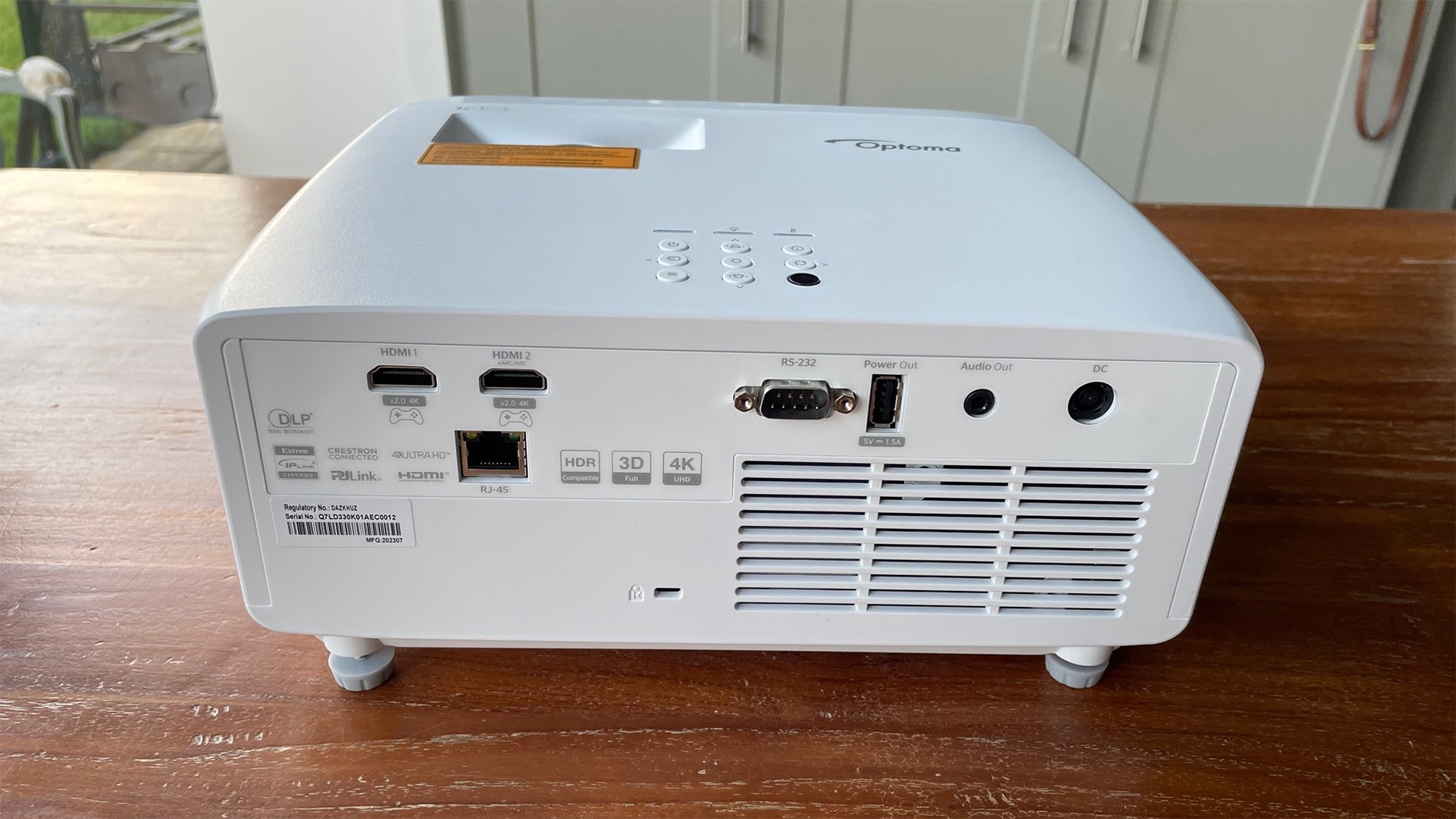
We’ve covered the UHZ66’s much-vaunted green credentials already, so let’s focus here – pun intended – on features that relate specifically to its performance.
Let’s start with the fact that the laser lighting system is reckoned to be capable of a huge 4000 lumens of peak light output. This much brightness should have the potential to deliver a stronger high dynamic range experience than most projectors (HDR10 and HLG formats of HDR are both supported), as well as making its pictures more likely to still be watchable even with quite a bit of ambient light in the room.
Whether the projector is also able to adapt to more serious lights-down movie nights with so much light to control, though, remains to be seen.
The UHZ66’s brightness is sufficient in conjunction with the projector’s DLP-based technology to enable Optoma to claim a maximum image size for the projector of over 300 inches, while its 1.4 - 2.24:1 throw ratio and impressively flexible 1.6x optical zoom mean it can produce a 120-inch image from as little as 12 and as many as 19.5 feet away from your wall or screen.
The UHZ66 doesn’t carry a full native 4K count of digital mirror devices (the DLP equivalent of pixels), but it uses so-called XPR technology to flash each mirror multiple times per image frame to create what ends up looking like a 4K image. In fact, America’s independent Consumer Technology Association has declared the 4K technology the UHZ66 uses to be the real 4K deal.
The 30,000 hours of claimed laser life the UHZ66 boasts is even more than we usually see with laser projectors, and is down to something Optoma calls DuraCore technology, where special laser diode cooling systems and an IP6X-rated dust-resistant design extend the system’s lifespan.
While Optoma clearly positions the UHZ66 as a gaming projector as well as a living room theatre projector, neither of its two HDMI ports supports 4K/120Hz gaming signals. Experimenting with different outputs from our resident Xbox Series X, though, finds that it can handle 1440/120Hz feeds, and 4K/60Hz feeds, with Optoma additionally stating that 1080p/240Hz feeds from sufficiently powerful PCs should also work.
We measured lag on the UHZ66 to be a very respectable 33.5ms with 60Hz sources, and this more or less halves with 120Hz feeds.
One of the HDMI ports supports HDMI’s eARC feature, so that the projector can pass audio through to a soundbar or AV receiver if the integrated 15W speaker system isn’t enough for you, while one of the USB ports is powered so that you can add an HDMI streaming dongle (such as a Roku stick or Google Chromecast). Unusually for today’s mid-range projector market, the UHZ66 doesn’t ship with any sort of smart/streaming system/device included as standard.
The connectivity also enables the UHZ66 to be added to a wider home control system, with integrated support for the AMX, Crestron RoomView and Extron IPLink systems.
Finally, while 3D has vanished without a trace from the TV marketplace, the UHZ66 still offers full HD 3D playback for people with 3D Blu-rays in their collection and who’ve been able to get their hands on compatible active shutter 3D glasses.
Picture
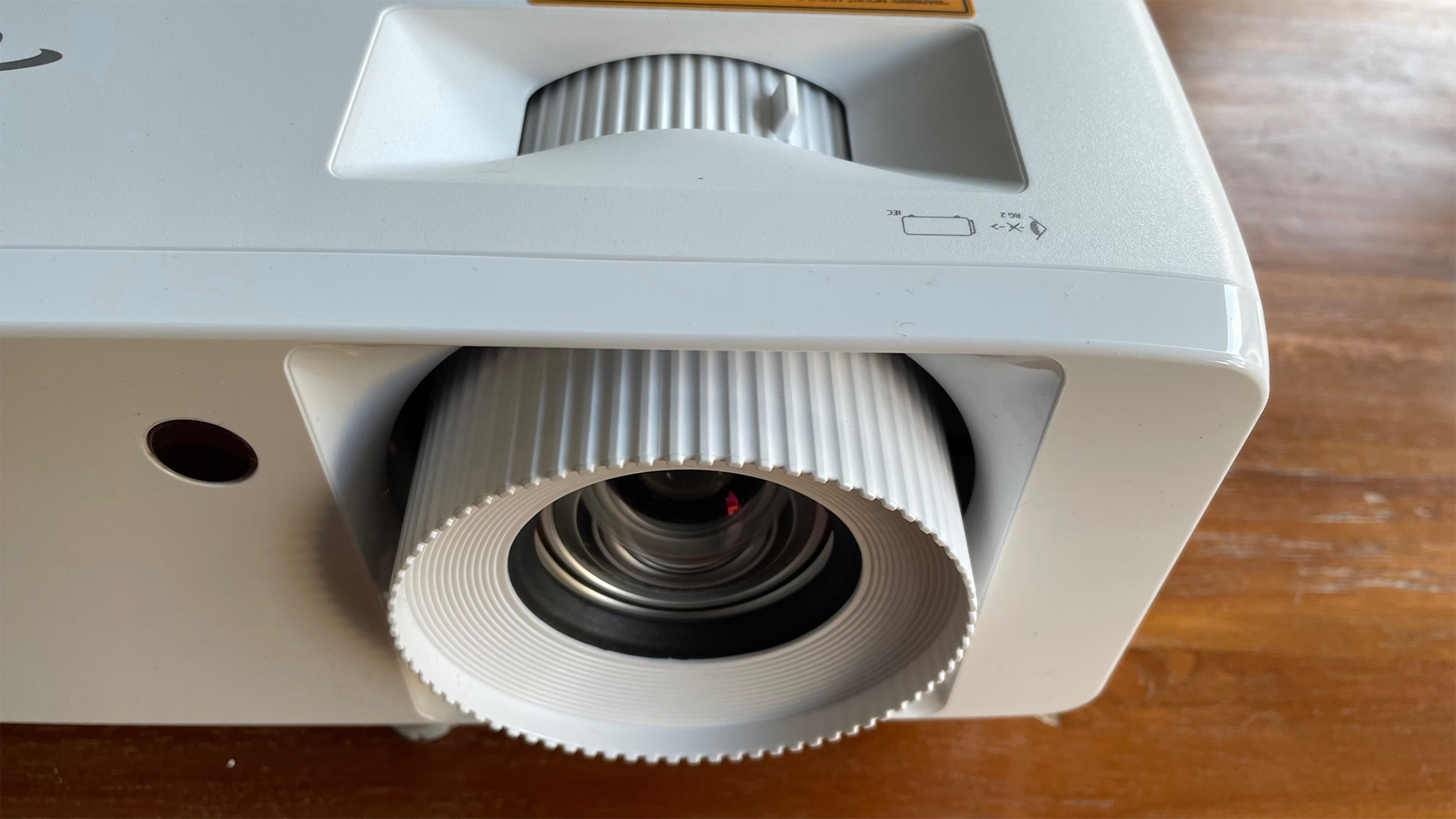
Even though DLP technology traditionally loses more of its source light along its optical path than rival LCD technology, the first thing that hits you about the Optoma UHZ66 is how incredibly bright it is. Its images blaze off the screen in a dark room, and still look startlingly punchy in a fairly bright room.
The intense brightness is enough to give you a clear distinction between standard and high dynamic range sources, too. This distinction is limited, to be clear, purely to brightness; as with all projectors the UHZ66 doesn’t support truly local light control, meaning it can’t deliver really bright HDR peaks and highlights in the way that mid-range and premium TVs can. Any visible HDR advantage a projector can manage at all, though, is generally to be respected.
Another knock-on effect of the UHZ66’s brightness is that it makes it really easy to appreciate how sharp its pictures are. It manages a strikingly dense and detailed image with 4K sources – and despite its high brightness, it builds on this core sharpness by doing a good job of avoiding clipping (lost shading and detail) in the brightest HDR image areas.
It delivers its sharpness without the image appearing to contain obvious pixel structure, too, resulting in a smooth, filmic finish, while HD sources are also mapped cleanly and crisply to the UHZ66’s digital mirror device.
The sense of sharpness holds up when images contain a lot of motion as well, with pretty much no motion blur and surprisingly natural-looking judder with 24p movie sources despite the image’s high brightness giving judder nowhere to hide.
The UHZ66 steps up to higher refresh rates very well too, delivering a responsive and smooth gaming experience that fits nicely with the image’s game-friendly brightness.
While all of the strengths we’ve just described show there’s a very capable core to the UHZ66’s picture performance, though, it also suffers from a couple of pretty substantial problems. Starting with the fact that its colours just don’t look right.
They don’t suffer from DLP’s so-called ‘rainbow effect’ of RGB striping noise as much as might have expected of such a bright projector, and blends with HDR sources are reasonably smooth and polished, but there’s a general paleness and lack of saturation as well as a rather yellowy hue to everything that’s particularly damaging to skin tones.
More predictably (since we’ve seen the same thing with a number of other high-brightness projectors in recent months), the UHZ66’s black-level response is also very average. Dark scenes look routinely grey and milky, especially with HDR footage, where the lighting system is required to deliver as much brightness as it can.
This greyness where rather there should be blackness limits contrast, and joins with the pale colours in making the picture feel generally rather flat and uninvolving, despite the efforts of the sharpness to inject a sense of three-dimensionality to proceedings.
The colour and contrast limitations are less noticeable by far if you’re watching the UHZ66 in a bright room, as the diluting effect of the ambient light essentially hides the weaknesses. But it doesn’t adapt to dark room viewing nearly as well as we’d like.
There are some measures you can take in dark room settings to improve things. Reducing the projector’s brightness setting by as much as 20-30 steps makes things feel more comfortable by improving black levels and making colour tones look more natural – though, of course, you’ve had to remove a large chunk of the projector’s most potent strength, its brightness, to get to this more balanced point.
A DynamicBlack feature that auto-adjusts light output based on image content makes a positive difference to black levels too – not least because it again takes quite a lot of the brightness out of the picture. It can cause some mild flickering during dark scenes as it tries to adapt to subtle picture changes, but these aren’t often severe enough to be distracting.
It’s also worth adding, while trying to put a more positive spin on the UHZ66’s lacklustre handling of dark scenes, that it does still bring out lots of subtle detail in the blackest corners, rather than such details being crushed out by the grey wash that hangs over everything.
While it’s good that there are at least tools available for limiting the UHZ66’s colour and black-level shortcomings, though, in the end we didn’t find any combination of settings that truly delivered the sort of immersive quality we’ve seen with so many other Optoma projectors.
Sound

On paper, the Optoma UHZ66’s integrated 15W speaker sounds like it could be powerful enough to do some damage (in a good way). It quickly becomes apparent, though, that it doesn’t actually do any damage at all.
It isn’t powerful enough to achieve really any sort of volume, for starters (despite the projector hilariously providing 100 different volume levels), creating an almost farcical mismatch between the scale of its pictures and the scale of its sound. Nor does its audio escape the confines of the projector’s bodywork, making its soundstage appear as small as it is quiet.
There’s essentially no bass to speak of, either, meaning that what little sound the UHZ66 produces sounds tinny and thin.
The only positive thing we can say about the UHZ66’s sound is that the projector runs surprisingly quietly for such a small but bright unit. Otherwise, though, we’d advise you to just consider the projector not to have any built-in audio and figure out your set-up accordingly.
Verdict
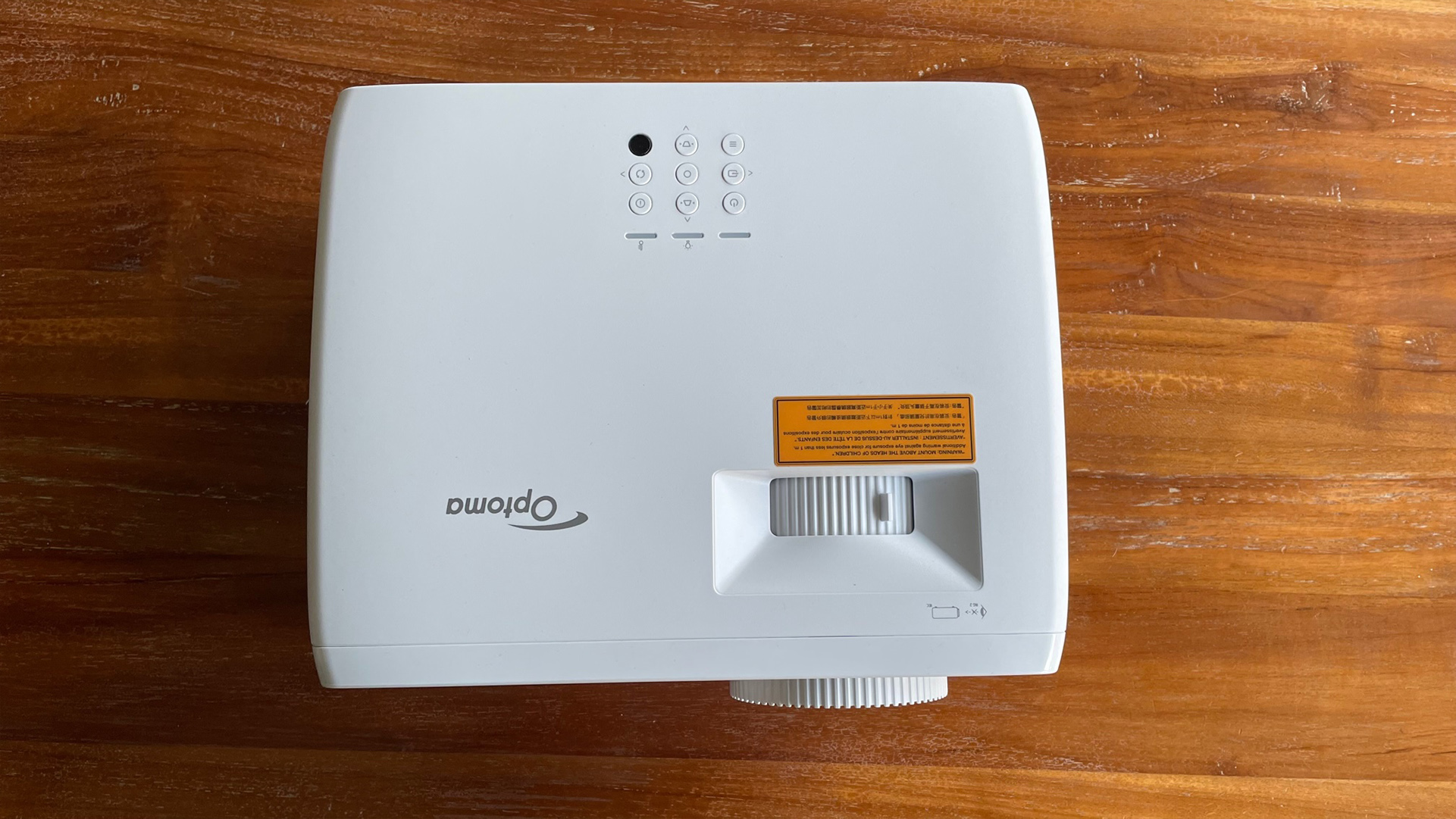
If you’re looking for an unusually compact, bright and eco-friendly projector for a generally light room, the UHZ66 is worth considering, especially if you’re fond of gaming as well as movies. It’s a pity, though, that in its push for brightness it loses track of some of the other picture quality strengths that Optoma projectors usually do so well.
SCORES
- Picture 3
- Sound 1
- Features 4
MORE:
Read our review of the Xgimi Horizon Ultra
Also consider the Epson EH-LS650
Read our Epson EH-TW7100 review
What Hi-Fi?, founded in 1976, is the world's leading independent guide to buying and owning hi-fi and home entertainment products. Our comprehensive tests help you buy the very best for your money, with our advice sections giving you step-by-step information on how to get even more from your music and movies. Everything is tested by our dedicated team of in-house reviewers in our custom-built test rooms in London, Reading and Bath. Our coveted five-star rating and Awards are recognised all over the world as the ultimate seal of approval, so you can buy with absolute confidence.
